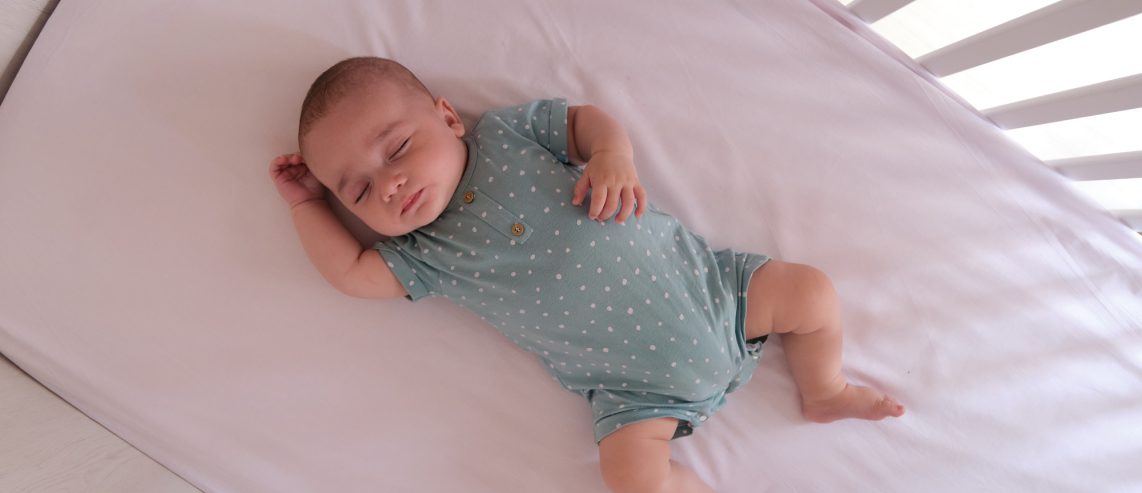Every tired new parent knows how frustrating it is when a baby is fussy and won’t sleep. Rocking, feeding, and swaddling your infant can help, but many families also swear by white noise.
Here’s a breakdown of what white noise is, the connection between white noise and sleep, and what parents need to know.
What Is White Noise?
White noise combines different noise frequencies to create a steady background hum. The continual low level of sound can mask distractions like street noise or a barking dog. It’s like the static you’d hear coming from a radio that’s between stations.
White noise played at a low volume can have a calming effect on babies, says the American Academy of Pediatrics. That’s because the muffled, humming sounds may remind babies of being inside the womb.
Never Miss a Beat!
Subscribe to Our HealthBeat Newsletter!
Thank you for subscribing!
You can now select the specific newsletters you'd like to receive.
You are already subscribed.
Subscribe to more newsletters in our email preference center.
Sorry, an error occurred. Please try again later.
Get Healthy Tips Sent to Your Phone!
What’s the Best Source for White Noise?
If you have an old radio, you can use it for white noise. You can achieve a similar effect with a whirring fan, an air filter, or running water. There are many white noise apps available to download on your phone or other device.
Many parents find it more practical to buy a white noise device for their baby. There are many of these products (sometimes called “infant sleep machines”) on the market. There are even high-tech bassinets that rock your baby to sleep while providing white noise.
Benefits of White Noise for Babies
White noise machines not only soothe fussy babies, they block out other annoying sounds so your baby can sleep. If you have other children or pets, or live on a busy street, white noise can be especially helpful.
There’s not much scientific research on the benefits of white noise for babies. But what there is suggests that white noise does help babies sleep.
In 1990, a study of 40 newborns found that 80% of those who listened to white noise fell asleep within five minutes. Of the babies who didn’t listen to white noise, only 25% fell asleep that quickly. A 2018 study found that babies who listened to white noise slept more and cried less than babies soothed in a swing.
Is White Noise Bad for Babies?
In recent years, some doctors have expressed concern about using white noise to help babies sleep. That’s because experts aren’t sure exactly how much white noise is safe for babies’ hearing. And in their enthusiasm to get their babies to sleep, parents may crank the volume too high for babies’ delicate ears.
A 2014 study in Pediatrics raised concern when it showed that several white noise machines produced sounds greater than 85 decibels (dB). That’s about the sound of city traffic or a gas-powered lawnmower. Sounds above 70 dB over a prolonged period of time may start to damage your ears.
In general, babies shouldn’t listen to sounds louder than 50 dB for long periods of time. That’s about the sound level of a quiet dishwasher.
Of course, it’s not possible to monitor each and every sound. A baby’s crying, for instance, can be over 100 dB. But it’s important for parents and caregivers to be aware of how loud white noise machines can be.
How to Use White Noise for Babies
Doctors advise erring on the side of caution when it comes to white noise and babies. As with any other device, you should use common sense when setting up a white noise machine.
Here are some basic rules to follow.
- Turn the volume down. Your white noise machine should be on the lowest possible setting.
- Keep it away from your baby. Place the machine at least seven feet away from your baby. Don’t put it on the crib rail, in the crib, or anywhere near your baby’s head.
- Don’t use it 24/7. Your baby needs to hear normal household noises. They especially need to hear you talking to them to learn language skills. So turn the white noise off during the day.
- Ease off as your baby grows. Gradually lessen the time you use the white noise machine, so your baby eventually learns to fall asleep without it. You want your baby to develop good sleep habits and eventually learn to fall asleep on their own.
Other Ways to Soothe Your Baby Along with White Noise
White noise played at a low level can be especially effective when you combine it with other methods of soothing your baby. Try these other calming methods along with white noise.
- Swaddling your baby. Wrapping your baby in a tight swaddle can mimic the feeling of being in the womb and helps them feel secure. You can safely swaddle your baby until they start to roll over on their own.
- Breastfeeding or bottle–feeding your baby. Your baby can’t tell you when they’re hungry, so offer breast or bottle when your infant fusses.
- Introducing a pacifier. Non-nutritive sucking can be soothing in small infants and may offer some protection against sudden infant death syndrome (SIDS).
- Rocking your baby. Repetitive, calming motions remind babies of the womb and help them settle down.
- Using a baby carrier. Your baby will feel secure and cozy hearing your heartbeat.
- Checking your baby’s diaper. No baby is happy with a wet or soiled diaper.
- Dimming the lights. As with loud noise, babies are sensitive to bright lights. A darkened atmosphere is more conducive to sleep.
- Having as much skin-to-skin time as possible. It’s calming for your baby to hear and feel your heartbeat and the warmth of your skin.
Of course, anytime you feel yourself losing your patience or control with a crying baby, it’s ok to take a break. Put your baby in a safe place (like their crib) and try to calm yourself down. Calling a trusted friend or relative can help.
Editor's Note: This article was originally published on , and was last reviewed on .
Sources
American Academy of Pediatrics, Infant Sleep Machines and Hazardous Sound Pressure Levels, Link
American Academy of Pediatrics, How to Calm a Fussy Baby: Tips for Parents and Caregivers, Link
Sleep Foundation, White Noise, Link
National Library of Medicine, Comparison between swinging and playing of white noise among colicky babies, Link
National Library of Medicine, White noise and sleep induction, Link
National Library of Medicine, Noise as a sleep aid: A systematic review, Link
CDC, What Noises Cause Hearing Loss, Link
National Sleep Foundation, How Technology Can Help You Sleep Better, Link
CNN, Sound machines for babies: Too loud? Too close? Link
Consumer Reports, Should You Buy a Snoo Smart Bassinet for Your Newborn? Link
About Pediatrics
From nutrition to illnesses, from athletics to school, children will face many challenges growing up. Parents often will make important health care decisions for them. We hope to help guide both of you in that journey. UPMC Children’s Hospital of Pittsburgh is a national leader in pediatric care, ranking consistently on U.S. News & World Report’s Best Children’s Hospitals Honor Roll. We provide expert treatment for pediatric diseases, along well-child visits, urgent care, and more. With locations across Pennsylvania, Maryland, and West Virginia, you can find world-class care close to home. We also work closely with UPMC Magee-Womens Hospital, a national leader in care for newborns and their mothers. Our goal is to provide the best care for your children, from birth to adulthood and beyond. Visit our website to find a doctor near you.

